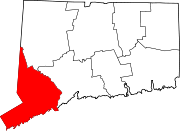
Fairfield is a town in Fairfield County, Connecticut, United States. It borders the city of Bridgeport and towns of Trumbull, Easton, Weston, and Westport along the Gold Coast of Connecticut. As of 2020, the town had a population of 61,512. The town is part of the Greater Bridgeport Planning Region.

Timothy Dwight was an American academic and educator, a Congregationalist minister, theologian, and author. He was the eighth president of Yale College (1795–1817).

The New Haven Green is a 16-acre (65,000 m2) privately owned park and recreation area located in the downtown district of the city of New Haven, Connecticut, United States. It comprises the central square of the nine-square settlement plan of the original Puritan colonists in New Haven, and was designed and surveyed by colonist John Brockett. Today the Green is bordered by the modern paved roads of College, Chapel, Church, and Elm streets. Temple Street bisects the Green into upper (northwest) and lower (southeast) halves.

The Old Campus is the oldest area of the Yale University campus in New Haven, Connecticut. It is the principal residence of Yale College freshmen and also contains offices for the academic departments of Classics, English, History, Comparative Literature, and Philosophy. Fourteen buildings—including eight dormitories and two chapels—surround a 4-acre (1.6 ha) courtyard with a main entrance from the New Haven Green known as Phelps Gate.

Southport is a census-designated place (CDP) in the town of Fairfield, Connecticut, United States. It is located along Long Island Sound between Mill River and Sasco Brook, where it borders Westport. As of the 2020 census, it had a population of 1,710. Settled in 1639, Southport center has been designated a local historic district since 1967. In 1971, it was listed on the National Register of Historic Places as the Southport Historic District.
Sereno Edwards Dwight was an American author, educator, and Congregationalist minister, who served as Chaplain of the Senate.
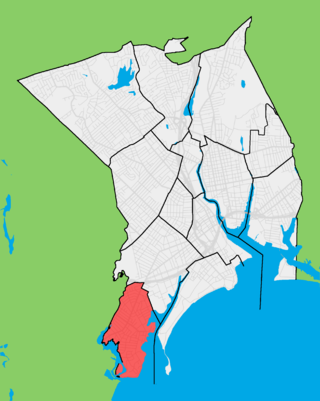
Black Rock is a neighborhood in the southwestern section of the city of Bridgeport, Connecticut. It borders Fairfield and the Ash Creek tidal estuary on the west, the West Side/West End of Bridgeport on the north and east, and Black Rock Harbor and Long Island Sound on the south. Black Rock comprises census tracts 701 and 702 and part of census tract 703. It includes two historic districts listed on the National Register of Historic Places. Residences comprise 86% of properties in Black Rock, 10% are commercial, and 4% are industrial or other property classes.

Green's Farms is the oldest neighborhood in the town of Westport in Fairfield County, Connecticut, United States. It was first listed as a census-designated place at the 2020 census.
The West Side of Stamford is the area immediately west of Downtown Stamford, covering the area north of Interstate 95 between the Greenwich town line and the Rippowam River. The northern boundary is commonly taken as West Broad Street and Palmers Hill Road. Another version of the boundaries of the West Side has it located between Stillwater Avenue, Broad Street, West Main Street and West Avenue up to Exit 6 Interstate 95.
The Central or Midtown section of Norwalk, Connecticut is an urbanized area in roughly the geographic center of the city, north of the South Norwalk neighborhood and the Connecticut Turnpike. Wall Street, West Avenue and Belden Avenue are the main thoroughfares. It has also been called "Norwalk Center" or "Downtown Norwalk".
Dixwell is a neighborhood of New Haven, Connecticut. Named for Dixwell Avenue, the main thoroughfare of the neighborhood which in turn was named for regicide judge John Dixwell, it is situated generally northwest of and adjacent to Downtown New Haven.

West Norwalk is a residential neighborhood in the city of Norwalk, Connecticut in the Connecticut Panhandle region of Fairfield County. It lies in the western central part of the city.
The Second Unitarian Church in Brooklyn was a historic church in Cobble Hill, Brooklyn, New York City. It was built from 1857 to 1858 and was demolished in 1962. The Church became known as a prominent cultural center in Brooklyn. One of the church's members, Mary White Ovington, co-founded the NAACP, and the church was an abolitionist hub.
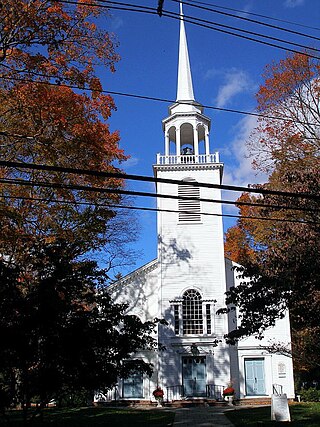
The Greenfield Hill Historic District encompasses the historic village area of the village of Greenfield Hill in northern Fairfield, Connecticut. The area was important from the mid-18th to 19th centuries as an intellectual center in the town, driven in part by Timothy Dwight, the Greenfield Hill Church minister and later president of Yale College. The district features a variety of architectural styles from the 18th to mid-19th century. It was listed on the U.S. National Register of Historic Places in 1971.

The Southport Historic District in the town of Fairfield, Connecticut is a 225-acre (91 ha) area historic district that was listed on the National Register of Historic Places in 1971. It preserves a portion of the modern neighborhood and former borough of Southport, Connecticut. Since the British burnt almost all of Southport's structures in 1779, there is only one home built prior to that date, the Meeker House at 824 Harbor Road, which survives.

The Connecticut Audubon Society Center at Fairfield is a nature center and wildlife sanctuary in the Greenfield Hill area of Fairfield, Connecticut. Constructed in 1971, the center features classrooms for environmental education programs, live animals on display, natural history exhibits, a nature library, a solar greenhouse and a gift shop. Outside there is a compound with non-releasable rescued birds of prey, including owls, hawks, peregrine falcons, a turkey vulture and other raptors.

Norwichtown is a historic neighborhood in the city of Norwich, Connecticut, United States. It is generally the area immediately north of the Yantic River between I-395 and Route 169.
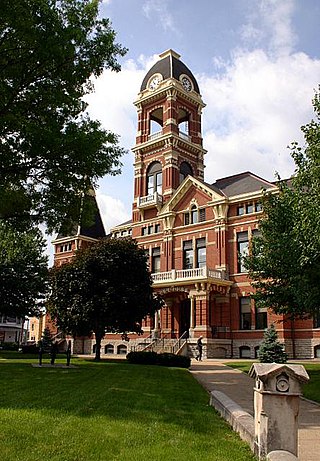
Albert C. Nash (1825-1890) was an American architect best known for his work in Milwaukee and Cincinnati.

Lambert & Bunnell was a long-lived American architectural firm from Bridgeport, Connecticut, in business from 1860 to 1901. It was established by Edward R. Lambert (1834–1904) and Rufus W. Bunnell (1835–1909).
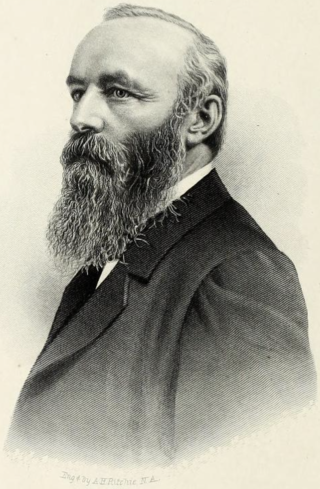
Oliver Henry Perry was an American politician from Connecticut. He served as Secretary of the State of Connecticut in 1854 and as a member of the Connecticut House of Representatives in 1847–1849, 1853, 1857, 1859–1860 and 1864.















